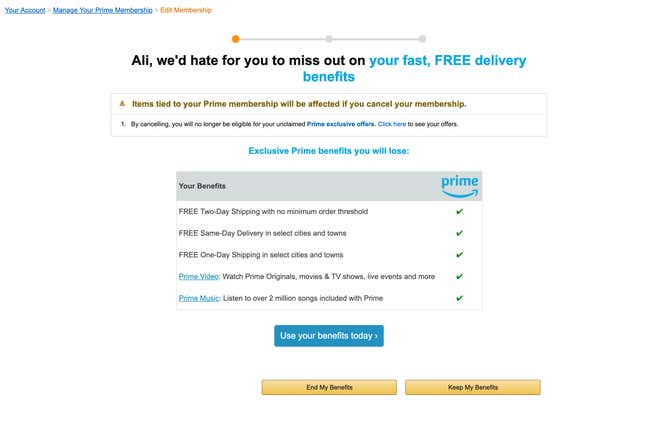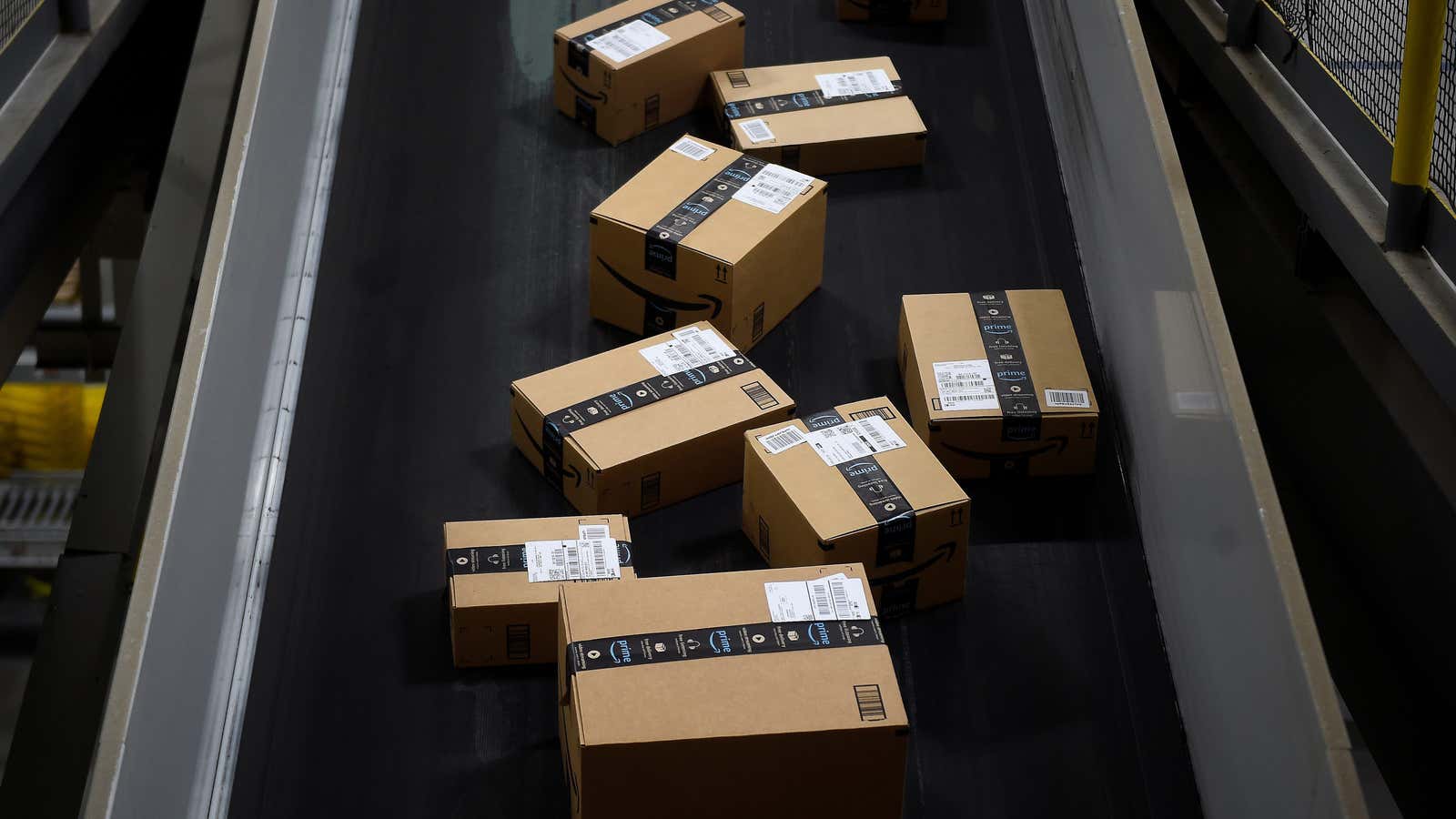I never really wanted Amazon Prime.
In the beginning, I signed up for Prime, Amazon’s signature membership program, to get access to the Washington Post. At the time in 2017, a one-year subscription to the Post cost $99. For the same price, I could sign up for Amazon Prime and get six months of the Post for free—Amazon CEO Jeff Bezos owns the paper—plus subsequent months for $3.99. If I had to pay $99 either way, I figured, I might as well get a Prime account too.
That first year I read the Washington Post a lot and used Prime a little. I lived in New York City, a place where almost anything you can think of—clothes, groceries, toiletries, window box planters, LED decorative lighting, the latest Mohsin Hamid novel—is nearby. From my apartment I could walk to Target, four grocery stores, two hardware stores, three pharmacies, two farmers’ markets, and countless restaurants. I worked five minutes from Home Depot, Best Buy, Harmon Face Values (the best health and beauty store you will ever find in Manhattan), Trader Joe’s, The Container Store, Staples, T.J. Maxx, Marshalls, and Bed Bath & Beyond.
Many people—probably most—don’t have this wealth of shopping options minutes from their home or office. But I did, and having Prime too felt excessive. I rarely bought in bulk, thanks to my apartment’s lack of storage space, so there was no appeal in placing large household orders. Reporting on Amazon had also made me uncomfortable with the company’s labor practices, corporate culture, treatment of third-party merchants, pageant-like hunt for a second North American headquarters, and everything Amazon knew about me. I never got used to the emails Amazon sent a day or two after I viewed but didn’t purchase a product. “Hello Ali,” Amazon would say, like we were friends. “Are you looking for something in our Charger & Adaptors store? If so, you might be interested in these items.”
The second year I got Prime by accident. Amazon automatically renews your Prime account, likely one reason why the service has such high retention rates. There’s no way to turn off this auto-renewal short of cancelling your account, but you can choose to get an email alert a couple days before your subscription is due to re-up. This email sailed through my inbox, in part because it looked like all those other automated emails Amazon sent me, which I reflexively deleted.
I used my accidental Prime to watch some Amazon TV shows (Fleabag, Catastrophe, Mozart in the Jungle) and to make the occasional online order. I decided that wasn’t enough to justify the subscription. Around January, with three months remaining in my subscription, I tried to cancel my Prime account. Amazon sounded the alarm.
“⚠️ Items tied to your Prime membership will be affected if you cancel your membership,” the cancellation page declared, listing benefits I would lose. There was no way to tell whether this would happen immediately, or if my Prime benefits would continue through the end of my current subscription. Googling also failed to clarify that point, so I asked Amazon’s press team.

“Prime members who have used their benefits can cancel their membership and will still have access to their Prime benefits until the next renewal period,” replied Lauren Englund, an Amazon spokesperson. “The date at which your membership ends and your benefits will be disabled is shown on the final page of the cancellation process.”
It struck me that this information would have been more useful to me, the consumer, on the first page of the cancellation process, but probably less useful to Amazon, which obviously intended to keep me enrolled. I asked Englund why Amazon didn’t include an option to stop Prime from auto-renewing instead of sending a reminder before that happened. “This option is shown on the final page of the cancellation process, ‘End on [XX date of next renewal period],'” Englund wrote.
Actually cancelling Prime requires you to confirm your intention three times. After its initial warning, Amazon asks you to consider “switching to monthly payments.” (Prime is more expensive on a monthly basis, at $12.99 a month, than with a now $119 annual membership.) On the third and final screen, Amazon finally told me the date my benefits would end. I cancelled.

How is life after Prime? Absolutely fine. It turns out you can still use Amazon without a Prime account, a fact that’s easy to forget when so much of the site feels geared toward Prime customers. Sure, stuff takes longer to ship, but there aren’t that many things most people need both urgently and unexpectedly, such that you can’t plan ahead and wait a week for them to arrive. I recently moved to London and used Amazon to buy a Brita filter—the water is extremely hard here—and a USB charger without any issues. Both even came more quickly than Amazon predicted. I know plenty of people with a Prime account who are happy to share the log-in for TV-streaming purposes. I still pay for the Washington Post.
I’m not saying you should cancel your Amazon Prime account. Everyone’s situation is different. Amazon can be essential for a lot of households, especially for people who don’t have access to a car or good transit, or the time to do their shopping themselves. Bezos famously said he wanted Prime to be “such a good value, you’d be irresponsible not to be a member.” The latest estimates on Prime adoption in the US from investment firm Cowen—63 million US households, roughly half of all households in the country—suggest Amazon has made good on Bezos’s words.
My point instead, ahead of Amazon’s fifth annual Prime Day shopping holiday, is to suggest you take a critical look at your Prime account and ask yourself whether you maintain it out of habit, or because you actually want or need it. It strikes me that Prime is hard to escape for three main reasons: It’s a really good service, it auto-renews, and, most importantly, it changes our behavior as consumers.
Prime, like many other digital services—Uber, Postmates, Instacart, to name a few—encourages us to shop impulsively, to expect that we can always hit a button and get something more or less on-demand. Amazon is currently pushing to make one-day shipping the norm on Prime, doubling down on the speed proposition, and it’s not hard to imagine that window shrinking to a few hours once the company gets drone deliveries off the ground. This approach to shopping is seductive, but slowing down your purchases can also feel good. If you change your mind, Amazon won’t hesitate to take you back.
